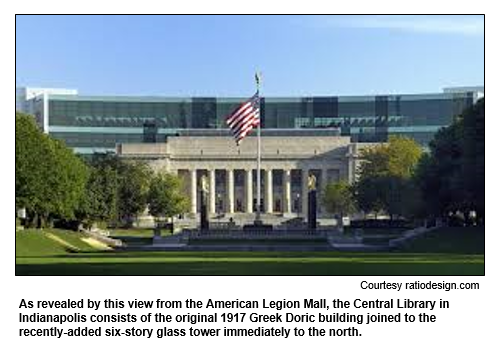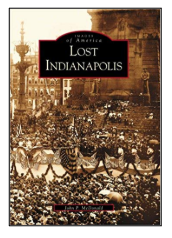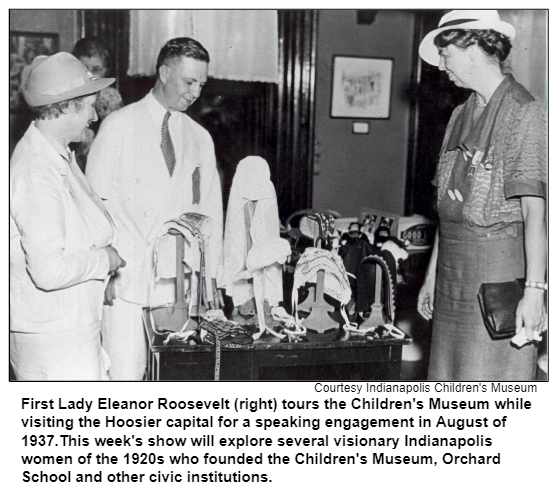
Saturdays, noon to 1 p.m. ET on WICR 88.7 FM.
Or listen live from anywhere on WICR Online!
Our call-in number during the show: (317) 788-3314
May 18, 2019
Brothels and streetwalkers in pre-1920 Indy: encore

To examine these aspects of the Hoosier state capital's social history, Nelson's studio guest on this encore show (originally broadcast July 8, 2017) is Paul Mullins, a popular professor in IUPUI's Department of Anthropology.
A historical archaeologist, Paul has researched and written about pre-1920 prostitution as part of a larger project titled "Invisible Indianapolis: Race, Memory, and Community Memory in the Circle City."
Along with co-director Susan Hyatt and a team that includes both undergraduate and graduate students, Paul has published the project's findings in a blog called Invisible Indianapolis.
The project's overarching goal: to show the historical impact of seemingly invisible urban social factors such as racial redlining, highway construction and gentrification.

- An area bounded by what is today Park Avenue (then called Liberty Street) and Market, East and Washington Streets.
- A district at the site of what is now another hospitality building, the Indiana Convention Center. The district ran along Senate Avenue near Georgia Street.
"Prostitution probably always was an element of the early cityscape, but some of the earliest evidence for houses of prostitution comes in the 1850s," Paul writes in the blog.
He quotes an 1857 newspaper account of a shooting at a brothel managed by a "mysterious woman." After the shooting, he adds, the illicit business "became the target of mob justice when [the woman's] brothel was set afire by a mob of more than 200 people."
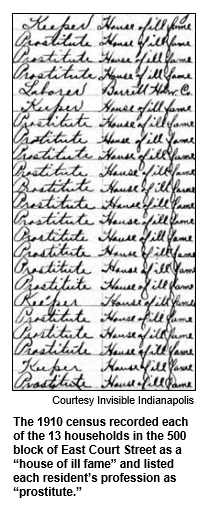
"The desperation of some women working as prostitutes was documented in a string of suicides and suicide attempts," Paul reports.
Paul Mullins is a past president of the Society for Historical Archaeology. For several years, Paul and his students could be seen during the summer months excavating sites near the IUPUI campus. Paul was a Hoosier History Live guest in 2009 when he was leading an excavation on the site of the long-demolished home of Madam Walker, the wealthy African-American entrepreneur and philanthropist.
According to Paul's research for Invisible Indianapolis, prostitutes often worked "in and around" Union Station during the late 1800s and early 1900s. (Before majestic Union Station opened during the 1880s, its predecessor, Union Depot, was the first train station in the country where competing railroad lines came together.)
Near the bustling train station, brothels were located among saloons and stores on South Street.
Farther east, a bygone street named East Court Street (now a parking lot between East and Park) had a cluster of brothels that Paul describes as "the city's most prominent concentration" of such businesses. In 1898, a Sanborn map "identified nearly every structure on East Court as a 'female boarding house,'" Paul writes, noting that at least 10 of these 16 homes listed in the 1899 city directory were brothels.
His blog describes attempts by local churches to encourage police raids of the brothels. Some of the churches also were active in the temperance movement.
Roadtrip: Indianapolis' Central Library
You might not think of a public library as a tourist destination, but guest Roadtripper Mick Armbruster recommends a sight-seeing visit to the Central Library in downtown Indianapolis. As the flagship of the Indianapolis Public Library system, this architectural gem offers outstanding examples of art, fascinating insights into history and an unparalleled view of the city skyline. Oh, and you might even check out some books during your visit as well!
Parking is available in an underground lot directly beneath the library from an entrance on Pennsylvania Street, or metered street parking is available. The main doors on the south side lead you to the library's original building, constructed in 1917 in classic Greek Doric style. Before you pass under the massive portico and through its enormous fluted columns, take a minute to gaze south at the American Legion Mall with its gilt statuary, gigantic American flag and fountains that all serve to memorialize the fallen soldiers of our nation's wars.
Once inside, take in the original library building's central hall (now called the Simon Reading Room). Its ceiling murals depict the history of written language, from the Rosetta Stone to the modern printing press, as well as scenes from Indiana's early exploration and settlement.
The heart of the modern Central Library is the massive, light-filled atrium that joins the original building to the modern glass tower that was added in 2007. Here you can pick up a snack in the cafe, people watch or make use of the library's free wifi Internet service. The atrium also provides access to the Learning Curve, the library's award-winning children's center, which offers state-of-the-art learning activities for kids.
Don't miss out on Mick's favorite part of the Central Library: the sixth floor of the modern building, which offers spectacular views of the city skyline. The sixth floor also houses the Special Collections Room, where history buffs can view such treasures as ancient Babylonian tablets, a leaf of a Gutenberg Bible, and signed copies of books by Booth Tarkington.
Nelson Price, host and historian
Molly Head, producer/project manager, (317) 927-9101
Michael Armbruster, associate producer
Cheryl Lamb, administrative manager
Richard Sullivan, senior tech consultant
Pam Fraizer, graphic designer
Garry Chilluffo, special events consultant
Please tell our sponsors that you appreciate their support!

 Acknowledgments to Monomedia, Visit Indy, WICR-FM, Fraizer Designs, Heritage Photo & Research Services, Henri Pensis, Aaron Duvall, Chloe Tyson, and many other individuals and organizations. We are independently produced and are self-supporting through organizational sponsorship and through individual contribution at the yellow button on our newsletter or website. For organizational sponsorship, which includes logos, links, and voiced credits in the show, contact Molly Head at (317) 927-9101 or email her at molly@hoosierhistorylive.org. Our media reach continues to grow via podcasting and iTunes.
Acknowledgments to Monomedia, Visit Indy, WICR-FM, Fraizer Designs, Heritage Photo & Research Services, Henri Pensis, Aaron Duvall, Chloe Tyson, and many other individuals and organizations. We are independently produced and are self-supporting through organizational sponsorship and through individual contribution at the yellow button on our newsletter or website. For organizational sponsorship, which includes logos, links, and voiced credits in the show, contact Molly Head at (317) 927-9101 or email her at molly@hoosierhistorylive.org. Our media reach continues to grow via podcasting and iTunes.
Thank you!
We'd like to thank the following recent, new and renewal contributors whose donations help make this show possible!
- Perry and Melanie Hammock
- Jim and Bonnie Carter
- Barbara and Michael Homoya
- Noraleen Young
- Barbara Wellnitz
- Phil and Pam Brooks
- Russ Pulliam
- Roz Wolen
- Marion Wolen
May 25, 2019 - coming up
Influential women in 1920s: Their enduring vision for culture and children in Indy
For nine years beginning in 1980, Mark Kesling was director of science for the renowned Children's Museum of Indianapolis. From 1993 to 2006, Mark was the academic director at Orchard School, a private school on the northside of Indianapolis.
Not only did both institutions date back to the 1920s, Mark noticed, but they were initiated by the same group of visionary women.
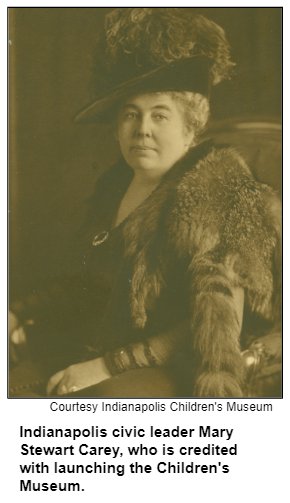
Mrs. Carey and several other women on the initial board of trustees of the Children's Museum also were members of the Progressive Education Association of Indianapolis. It met in 1922 to begin planning what became Orchard School, an elementary school (now K-8) founded to emphasize individualized instruction and learning through children's direct interactions with their environment.
To share details about these 1920s-era women civic leaders and their vision, Mark Kesling will be Nelson's studio guest.
Mark is the founder and CEO of The daVinci Pursuit, a non-profit organization that uses art to engage the community in science education opportunities. He also is the co-host, with Jill Ditmire, of She Says Art, He Says Science, the program on WICR-FM (88.7) that follows Hoosier History Live at 1 pm on Saturdays.
In addition to discussing the women civic leaders of the 1920s who helped launch the Children's Museum and Orchard School, Mark and Nelson will time-travel to 1916 to explore another cultural initiative of women that endures to this day. Inspired by the state's Centennial celebrations in 1916, women civic leaders initiated a contest to design the Indiana state flag. The winning entry, designed by Mooresville-based artist Paul Hadley, remains the state flag more than 100 years later.
In 1925, the initial home of the Children's Museum was the carriage house of the Propylaeum, 1410 N. Delaware St., a women's advocacy organization. In addition to women civic leaders such as Edith Whitehill Clowes and Elizabeth Browning, former director of the Indianapolis Public Library, influential figures in the early years of the Children's Museum included architect Kurt Vonnegut Sr., the father of the future novelist.
Note: This show may be partially or fully preempted by WICR-FM's live coverage of UIndy sports.
© 2019 Hoosier History Live. All rights reserved.
|
